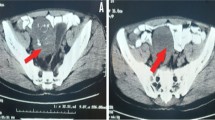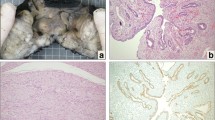Abstract
Correlation of the gonadal position and müllerian duct derivative regression was estimated in 17 patients with ambiguous genitalia and dysgenetic gonads. Six out of ten testes located at or beyond the internal inguinal ring were not associated with fallopian tubes on the same side. Four of those six testes were cryptorchid, including two that were located at the internal inguinal ring. All six intra-abdominal testes were associated with an ipsilateral fallopian tube. These findings can be explained by the two-stage model of testicular descent where migration from the posterior abdominal wall to the internal inguinal ring, the transabdominal phase, is closely related to müllerian duct regression, suggesting a role for müllerian inhibiting substance in this phase.
Similar content being viewed by others
References
Brook CGD, Wagner H, Zachmann M, et al (1973) Familial occurrence of persistent mullerian structures in otherwise normal males. Br Med J 1: 771–773
Donahoe PK, Crawford JD (1986) Ambiguous genitalia in the newborn. In: Welch KJ, Randolph JG, Rairtch MM, O'Neill JA, Rowe M (eds) Pediatric Surgery, 4th edn. Year Book Medical Publisher, Chicago, pp 1363–1382
Husmann DA, McPhaul MJ (1991) Time-specific androgen blockade with flutamide inhibits testicular descent in the rat. Endocrinology 129: 1409–1416
Hutson JM (1986) Testicular feminization. A model for testicular descent in mice and men. J Pediatr Surg 21: 195–198
Hutson JM, Donahoe PK (1986) The hormonal control of testicular descent. Endocr Rev 7: 270–283
Josso N, Fekete C, Cachin O, et al (1983) Persistence of mullerian ducts in male pseudohermaphroditism, and its relationship to cryptorchidism. Clin Endocrinol 19: 247–258
Aaronson AA, (1992) Sexual differentiation and intersexuality. In: Kelalis PP, King LR, Belman AB (eds) Clinical pediatric urology, 3rd edn. WB Saunders, Philadelphia, pp 977–1014
Migeon CJ, Berkovitz GD (1992) Congenital defects of the external genitalia in the newborn and prepubertal child. In: Carpenter SE, Rock J (eds) Pediatric and adolescent gynaecology. Raven Press, New York, pp 77–94
Mouli K, McCarthy P, Ray P, et al (1988) Persistent mullerian duct syndrome in a man with transverse testicular ectopia. J Urol 139: 373–375
Robboy SJ, Miller T, Donahoe PK, et al (1982) Dysgenesis of testicular and streak gonads in the syndrome of mixed gonadal dysgenesis: perspective derived from a clinicopathologic analysis of twenty one cases. Hum Pathol 13: 700–716
Scott JE (1987) The Hutson hypothesis. A clinical study. Br J Urol 60: 74–76
Short RV (1982) Sex determination and differentiation. Reproduction in mammals. In: Austin CR, Short RV (eds) Embryonic and fetal development, 2nd edn Cambridge University Press, Cambridge, pp 70–113
Simpson JL (1992) Genetics of sexual differentiation. In: Carpenter SE, Rock J (eds) Pediatric and adolescent gynecology. Raven Press, New York, pp 1–37
Stallings MW, Rose AH, Auman GL, et al (1976) Persistent mullerian structures in a male neonate. Pediatrics 57: 568–569
Spencer JR, Torrado T, Sanchez RS, et al (1991) Effects of flutamide and finasteride on rat testicular descent. Endocrinology 129: 741–748
Walsh PC, Madden JD, Harrod MJ, et al (1974) Familial incomplete male pseudohermaphroditism, type 2. Decreased dihydrotestosterone formation in pseudovaginal perineoscrotal hypospadias. N Engl J Med 291: 944–949
Wilson JD, George FW, Griffin JE (1981) The hormonal control of sexual development. Science 211: 1278–1284
Author information
Authors and Affiliations
Additional information
Correspondence to: J. M. Hutson
Rights and permissions
About this article
Cite this article
Abe, T., Hutson, J.M. Gonadal migration in ambiguous genitalia. Pediatr Surg Int 9, 547–550 (1994). https://doi.org/10.1007/BF00179677
Issue Date:
DOI: https://doi.org/10.1007/BF00179677




